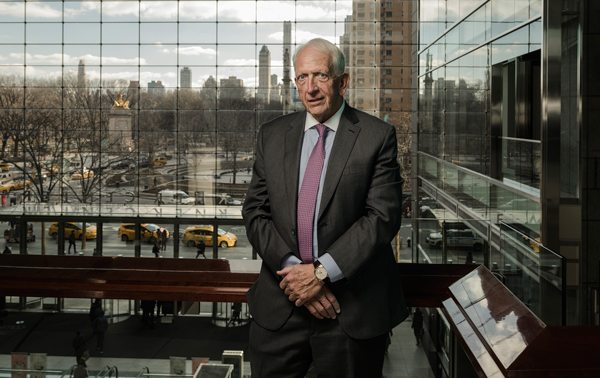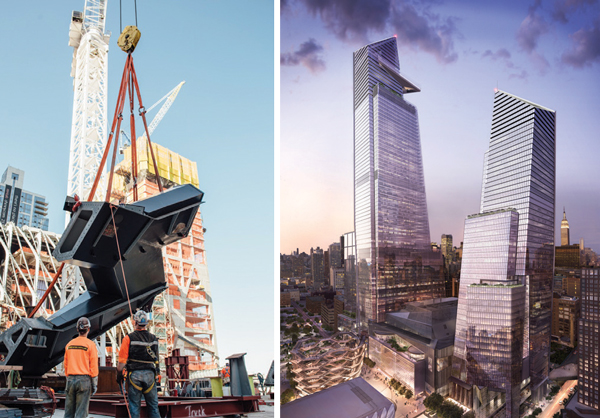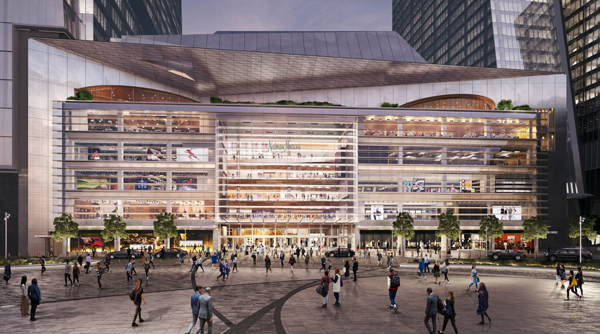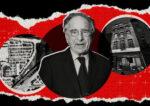Trending
How is Himmel shaping Hudson Yards?
The Related Urban CEO is feverishly curating a retail smorgasbord at the firm’s legacy-defining project, but this time there’s no “doughnut hole”

Ken Himmel was sitting in his Boston office after lunch one quiet afternoon in the mid-1990s when the phone rang. It was his old friend Stephen Ross.
“How quickly can you get to New York City?” asked Ross, the president and founder of the Related Companies. “Can you come for dinner? I have something I want to talk to you about.”
Himmel, an affable, snowy-haired mixed-use guru — with a résumé that already included the development of some of the nation’s most successful vertical shopping malls — was intrigued. Himmel had known Ross since the 1970s, when the two were newbies in the business. He knew Ross well enough to know that it would be worth the quick shuttle flight.
WATCH: Can Related apply its
Time Warner Center touch to Hudson Yards?
That night, over dinner and drinks at the Post House, an Upper East Side steak bistro, Ross made his pitch. He was planning to bid on what was arguably the most important New York City real estate project in a generation — the redevelopment of Columbus Circle. Would Himmel help him?
The two began strategizing on the project the next morning. And the rest, as they say, is history.
There were many watershed moments in the life of what is now known as the Time Warner Center, the 2.8 million-square-foot complex that transformed Columbus Circle — and set the stage for Related’s current megadevelopment at Hudson Yards. But the arrival of Himmel, now president and CEO of Related Urban, was one of the most consequential.
At Hudson Yards, Himmel is spearheading the hotel-and-retail ground game and collaborating on the overall real estate mix that’s already transforming 28 acres of former railyards into a mini-city. Retail is, not surprisingly, a huge piece of the puzzle — despite the ongoing national retail “apocalypse” resulting from today’s buy-it-on-Amazon mentality.
The number of retailers who declared bankruptcy in 2017 reportedly hit a six-year high, and malls have taken an especially big hit. New York retail has not been exempt from this disruption. In 2017, asking rents across 16 retail corridors in the city declined by 18 percent year over year, according to CBRE.
Against this backdrop, Related and its partners — Oxford Properties Group and Mitsui Fudosan America — are forging ahead at full force. In September, they closed on $3.8 billion in financing for 50 Hudson Yards, bringing the total equity and debt raised for the $25 billion project’s first seven buildings to roughly $18 billion.
So the stakes for making it all work are stratospherically high.
Hello, hospitality
A native of Swampscott, Massachusetts, Himmel caught the hospitality “bug” early, working at a local country club as a teenager and at a five-star-resort at Colonial Williamsburg in Virginia while attending the College of William & Mary nearby.
After graduating Cornell University’s School of Hotel Administration, he landed a meeting with a Boston entrepreneur named George Page and convinced Page to hire him as an assistant. For the next three years under Page, Himmel helped oversee one of the region’s highest-grossing restaurants as well as seven Hilton franchises and the construction of three more.
 Then in 1973, he jumped to development firm Cabot, Cabot & Forbes, which had built much of Boston’s skyline.
Then in 1973, he jumped to development firm Cabot, Cabot & Forbes, which had built much of Boston’s skyline.
On a business flight home from California, where he was working on a troubled hotel, Himmel snagged the seat next to the firm’s CEO, Gerald Blakely. By the time the plane landed, he said, he’d convinced Blakely to consider appointing him to oversee construction of a Ritz-Carlton Hotel at the 78-story mixed-use project called Water Tower Place in Chicago, which opened in 1975 and was one of the first true urban vertical mixed-use projects. Getting that job was a pivotal break in Himmel’s young career.
When CC&F’s Chicago partner, the Klutznick family, bought out the firm’s stake in the project, Himmel stayed on. Then when it wrapped, he headed back to Boston and found a site for the Klutznick’s next project: the 3.5 million-square-foot Copley Place complex.
Around this time, in the late 1970s, Himmel received an invitation to participate in a networking group. The group — which was made up of about 20 real estate up-and-comers and informally dubbed the “real estate roundtable of young guys” — included a developer who was doing affordable housing. His name was Stephen Ross.
Granddaddy of mixed-use
When Ross and Himmel sat down years later to strategize about the Time Warner Center, it was already clear that the retail would be one of the trickiest parts of the project.
Ross and his main financial partner, Richard Mack, president of what was then Apollo Real Estate Advisors, had just developed the nearby mixed-use Park Imperial, where they locked in $1,400 a square foot for some of the condos. So, the two were fairly confident they could get at least $1,500 a square foot this time.
“And we felt with that price, we could do well on the job,” said Mack, adding that they ended up getting about $2,450.
But Ross knew that the retail would be key to bringing the area to life — and that if it flopped, many would deem the project a failure.
At the time, the idea of a large vertical New York City mall was controversial.
“People said it would fail because people don’t shop on the West Side,” Ross recalled. “But if you listen to everybody, you’re doomed for failure.”
While Ross had dabbled in mixed-use, he knew he needed help to pull off “the granddaddy of all mixed-use projects.”
After signing on, Himmel also heard from the skeptics, who predicted that New Yorkers would thumb their noses at eating and shopping in a mall.
Like Copley Place, the Columbus Circle project was a centrally located no man’s land with activity bustling around it — or as Himmel likes to call it, a “hole in the doughnut.”

The first piece of the Vessel being placed; a rendering of 10 and 30 Hudson Yards
“The [pedestrian] traffic stopped when it got to Columbus Circle, because there wasn’t much draw to come here,” Himmel said. “And yet you were in the most strategic location visibility-wise in the whole city.”
Himmel and Ross settled on what they hoped would be a powerful draw: Jazz at Lincoln Center, which they placed in a fifth-floor space that would otherwise have been used for a more lucrative retail tenant. The move not only helped them convince the city — which was selecting the developer for the former New York Coliseum site — to award Related the project, it enticed a steady stream of affluent shoppers into the structure. Himmel had another strategy to lure people into the building: food. In fact, he made the risky bet that placing top-flight restaurants on high floors would push customers into the mall, too. But not everyone was convinced.
Restaurateur Danny Meyer, for one, was unimpressed, Himmel said, noting that Meyer declined to sign on and warned that vertical malls had never worked in New York.
And he wasn’t the only one. “Everybody was telling all of us it wouldn’t work,” Himmel said.
Joe Rose, who was head of the City Planning Commission during the Giuliani administration and played a key role in selecting Related for the project, said that while the firm made a compelling case, it was still “a risk.”
“We didn’t know it would work,” Rose said. “We hoped it would work; the deal was structured so that Related and Himmel in particular had a huge bet on making it work.”
Himmel did succeed in recruiting celebrity chef Thomas Keller to open Per Se there.
Keller, whose restaurants include the renowned The French Laundry in the Napa Valley, recalled being enticed by Himmel’s restaurant knowledge and the opportunity Himmel and Ross offered him: Not only did they want him to open his own restaurant, they asked him to help curate all of the others. In the end, Keller became a vertical-mall proponent.
Himmel and Ross also took the unorthodox tack of putting Whole Foods in the basement, sending its executives to London to scope out Harrods’ food hall and to other European cities for ideas. The supermarket was initially so crowded that Related had to hire a guard to ensure the store didn’t violate the fire code.
As they inked retail tenants, Himmel and Ross quickly discovered that their location was both a blessing and a curse. Few of the highest-end luxury retailers opted for space there because it was too close to their Fifth Avenue flagships. But Related found the sweet spot in what Himmel calls “bridge brands” — like Coach, Stewart Weizman, Hugo Boss, J. Crew, William Sonoma and Michael Kors.
The project, by all accounts, is a major success story.
Not just Neiman
But if Time Warner was big, Hudson Yards is gargantuan. And it’s not the same kind of a hole in the doughnut. Rather, Related — now helmed by Jeff Blau, with Ross as chairman — is constructing an entirely new neighborhood with more than 18 million square feet of real estate.
And it’s doing it in a far tougher market.
Still, as with the Time Warner Center, which has about 300,000 square feet of retail, the shopping and culinary options will be crucial to the project’s success.
This time around there’s over 1.2 million square feet of retail throughout the project.
“The scale is much, much bigger,” Himmel said. “But when you think about it … the scale of Hudson Yards had to be big enough to make sure you created a real destination.”

A view of the plaza
Related has already sold and leased the vast majority of the office space it’s developed so far to blue-chip companies including Coach, L’Oréal, BlackRock, Kohlberg Kravis Roberts and Wells Fargo Securities. While the traffic from those companies and the 4,000 new residential units will go a long way toward populating the neighborhood, the project is also intended to be a destination in and of itself.
The centerpiece of its public space will be a $200 million, 15-story Thomas Heatherwick-designed structure dubbed the Vessel. The interactive structure, which will include 154 interconnecting flights of stairs and require a ticket for entry, will sit on a five-acre public plaza that will also include the 200,0000-square-foot cultural center known as the Shed.
David Childs — the Skidmore, Owings & Merrill starchitect who designed 35 Hudson Yards, a mixed-use tower with 137 residential units, an Equinox hotel, office space and retail, including a restaurant overlooking the plaza — said melding all of those uses together is what brings the project to life.
“It is not just because it makes higher financial return on those uses than the office building, but to create a diversity,” said Childs, who also designed the Time Warner Center.
Just across the plaza from 35 Hudson Yards, facing 10th Avenue, will sit the Shops & Restaurants at Hudson Yards, the retail hub of the project. The site, which is 70 percent leased, is expected to attract more than 24 million people annually and generate $1 billion a year in retail sales, according to company estimates from 2015.
And restaurants are, of course, again a key part of the strategy to draw people in and up. In addition to 750,000 squaare feet of retail, the mall will include 100,000 square feet of fine dining.
Himmel — who has a team of 10 at Related Urban — has again enlisted Keller to help curate. In total, they’ve recruited 20 food and beverage venues so far and plan to announce others soon.
Hudson Yards’ answer to Time Warner’s Whole Foods will be a 39,000-square-foot Spanish market by famed Washington, D.C., chef José Andrés.
Instead of Jazz at Lincoln Center, the lure at the top of the retail complex will be Neiman Marcus.
To snare the department store, Himmel tapped architect Howard Elkus, who he teamed up with to recruit Neiman to Copley Place years before. The two flew to Dallas around 2013 to pitch Neiman’s CEO Karen Katz, who retired last month, and its board.
“You get the penthouse levels of the project,” Himmel told them, noting that the destination restaurants surrounding the space would ensure customers.
In 2014, Related and Neiman announced that the department store would anchor the Shops with a 250,000-square-foot store spanning three levels.
From there, Chanel, Louis Vuitton and 15 other luxury brands that already had relationships with Neiman took space.
But in September last year, the New York Post reported that Neiman — which has been financially struggling and is saddled with $5 billion in debt left over from a 2005 leveraged buyout — would scale its footprint back. The company denied those reports, but it’s now reportedly taking 190,000 square feet.
(Related said the size of the Neiman sales floor has not changed, and the reduction is a result of efficiencies in the back of the store, used only for storage, infrastructure and other nonsales operations).
But as recently as last month, CreditRiskMonitor, which assesses corporate financial risk, reported that the department store is at an “elevated risk of bankruptcy.”
While Neiman posted its first increase in two years for same-store sales in the fourth quarter, it still has a long way to go to turn things around.
“They are going to be super challenged to improve performance of the company enough to get out of the debt hole that they’re in,” said CreditRiskMonitor’s William Danner.
If the company cannot turn things around, it will either have to restructure its debt or declare Chapter 11 bankruptcy, which at the very least would likely result in the renegotiation of the Hudson Yards lease, Danner said.
Related declined to comment on Neiman other than to note that its plans to open are on track and construction is in full swing. Regardless of Neiman’s current financial situation, it’s still a high-end luxury brand that brought Hudson Yards retail chits.
In addition to making the property more attractive to lenders — the partners landed a $1.5 billion construction loan in 2015 led by Bank of China and Deutsche Bank on the 1 million-square-foot Shops — Neiman also helped win more retailers. After Neiman signed on, Related locked in H&M and Zara, which will each have stores spanning two floors. Sephora, Aritzia, Lululemon, Rolex and Patek Philippe are all also signed on. And last month, in a major coup, it announced that high-end Dallas-based designer Forty Five Ten agreed to take 16,000 square feet.
Back in 2015, the New York Times quoted Himmel saying: “Our most expensive floor is predictably our plaza level, which is our ground level. Rents there are in the average of $500 to $650 a square foot. That’s just retail. Restaurants are much lower. And the rents move down as you go up.”
But several broker sources said asking retail rents at Hudson Yards are currently about $200 to 300 on the ground floor and $100 to $200 on upper levels.
Related declined to reveal its rents, only saying that because of its overall leasing success at Hudson Yards, it has the flexibility to be selective and “curate the best selection of retailers and restaurants.”
CBRE’s Richard Hodos — who is currently representing Michael Kors, which is looking to sublease its space at the Time Warner Center — said he expects the project to open successfully, but that the true test will be what happens after that. “Ken Himmel is a genius,” he said. “If anyone else was opening Hudson Yards, there would be a big question mark. … It’s not the easiest thing to lease these days, but if anyone can do it, they can. Himmel is the Steven Spielberg of the business.”
Escaping the mall fate?
Himmel’s reliance on “experiential” retail, including restaurants, is in keeping with current retail trends.
That’s because without a compelling draw, retailers may be in trouble, sources say. In 2017, roughly 50 retailers filed for bankruptcy, according to MarketWatch. They included Toys “R” Us, True Religion Apparel and BCBG Max Azria.
Jan Rogers Kniffen, the founder of an eponymous retail consulting firm, said that of the nation’s 1,083 enclosed shopping malls, about a third are likely to fail in the coming years.
But he placed Hudson Yards in a different category.
“New York City is far from typical of anything,” he said. “Do I think Hudson Yards will be a success? Yes. Do I think malls in general in the United States are on a trend of success? Absolutely not.”
Trevor Noren, a Brooklyn-based retail analyst at 13D Global Strategy & Research, said that more generally, rising income inequality has bifurcated the retail market and gutted middle-class retail. He cited the so-called “60 percent versus the 40 percent” reality: The 60 percent (the have-nots) frequent discount chains, while the 40 percent (the haves) go for high-end retail.
“Retail systems that walk the middle ground — which is most of suburbia since the 1950s — that’s where you are seeing cratering of retail,” he said.
Interestingly, as the Wall Street Journal recently reported, much of the capital pouring into Hudson Yards has come from foreign lenders. Those lenders stepped in to fill a void left by U.S. banks, which scaled back construction lending in the wake of the financial crisis.
Manhattan-based attorney Joshua Stein, who specializes in commercial real estate financing, said that while there is “a lot on the line” at the project, the $18 billion in equity and debt is being deployed prudently.
“It’s a very big site,” he said. “But it’s not really just one project. It’s a whole series of projects. The good thing about multiple projects is you don’t do the next building until you’re ready to build another. You build one, see how it works, and then you build another when it’s time.”
“So,” he added, “the idea that $18 billion of financing could fall on its face just isn’t going to happen.”
—Adam Piore is currently working on a book for The Real Deal on the history of New York City real estate from September 11, 2001, to the present.




